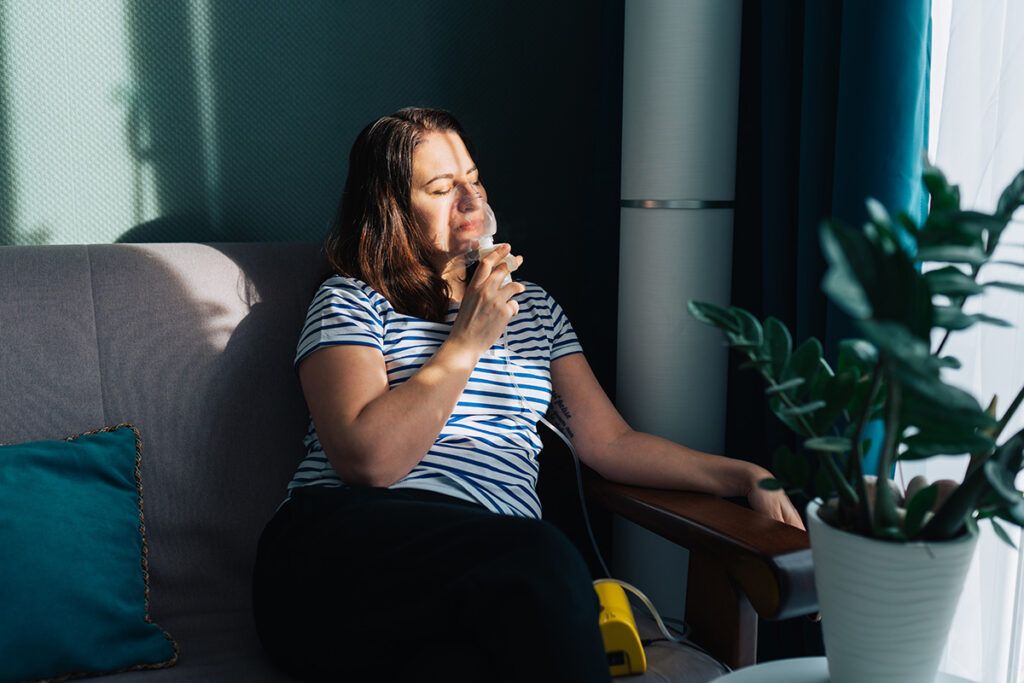COPD is an umbrella term for conditions that permanently affect your respiratory function and make it hard to breathe. Emphysema and chronic bronchitis are two types of COPD.
COPD is a progressive condition, meaning symptoms develop and worsen over time.
To identify which stage of the disease someone is at, medical professionals use an international grading standard called GOLD, which stands for Global Initiative for Chronic Obstructive Lung Disease. The system provides grades to classify the stages of COPD based on symptom severity.
This article discusses the four stages of COPD according to GOLD, how they’re measured, and which treatments are recommended at each phase.
GOLD stages or grades for COPD

A health professional measures lung function and airway obstruction using spirometry.
The spirometry test documents the forced expiratory volume (FEV). In other words, the test measures how hard you can blow air out. Sometimes, doctors repeat the test after you take one dose of a bronchodilator, a drug that relaxes the airways.
Your results help the medical professional determine if you have COPD, and if so, which stage of the disease you’re likely at. This information, together with your medical history and contributing factors, is then used to decide on treatment options.
Spirometry test results are read as follows:
- Grade GOLD 1: FEV is greater than 80%. Mild obstruction.
- Grade GOLD 2: FEV is between 50% and 79%. Moderate obstruction.
- Grade GOLD 3: FEV is between 30% and 49%. Severe obstruction.
- Grade GOLD 4: FEV is less than 30%. Very severe obstruction.
What are the signs that COPD is getting worse?
People with COPD may have periods where their symptoms get worse. This is called a COPD flare or exacerbation. It’s usually caused by a lung or airway infection, but may also have no known cause.
Signs of a COPD exacerbation include:
- increased shortness of breath
- worsening cough
- change in color of mucus (to greener or yellower) from the respiratory tract
- increased fatigue
- lower oxygen levels
If you get early treatment for a COPD exacerbation, it can stop the flare from getting worse.
How quickly does COPD progress?
COPD is progressive. Symptoms get worse over time. Still, how quickly that happens varies from person to person and may depend on the disease stage.
Lifestyle strategies, managing respiratory infections, and following a COPD treatment may help prevent COPD flare-ups and slow down progression, particularly during the early stages.
During later stages of COPD, at home or hospital oxygen therapy may provide temporary relief when your blood oxygen level is low. It won’t stop the disease progression, though.
GOLD groupings for COPD treatment
After a spirometry measurement, your healthcare team may assign you a GOLD group based on your reported symptoms and history of COPD flares or exacerbations. This will help your health team determine the most indicated treatment for your case.
To assess the severity of your symptoms, your doctor may use the modified British Medical Research Council (mMRC) questionnaire and the COPD Assessment Test (CAT). The first measures levels of breathlessness and the second measures how much COPD symptoms interfere with your quality of life.
These test scores together with your exacerbations lead to a GOLD grouping of A, B, C, or D:
- GOLD Group A: One or fewer breathlessness exacerbations that do not require a hospital visit. Low scores on mMRC and CAT. The treatment recommendation may be a bronchodilator.
- GOLD Group B: One or fewer exacerbations that do not require a hospital visit. High scores on mMRC and CAT. The treatment recommendation may be a long acting beta-agonist drug or a long acting anticholinergic.
- GOLD Group C: Two or more exacerbations, or one exacerbation that requires a hospital visit. Low scores on mMRC and CAT. The treatment recommendation may include a long acting anticholinergic.
- GOLD Group D: Two or more exacerbations, or one exacerbation that requires a hospital visit. High scores on mMRC and CAT. The treatment recommendation may be a long acting anticholinergic, a combined long acting beta-agonist and long acting anticholinergic, or a combined inhaled corticosteroid and long acting beta-agonist.
It is possible that the symptoms you experience do not match the spirometry results. For example, you may not have any symptoms but have grade GOLD 3 or 4 spirometry results.
If that’s the case, your healthcare professional may want to perform more tests before offering a treatment recommendation.
Treatment for COPD
Treatment for COPD usually starts with medications to help you breathe better. In cases of severe COPD, doctors may assess the need for oxygen therapy.
Medication
COPD treatment may include medications like:
- bronchodilators and anticholinergic inhalers to relax and open the airways
- anti-inflammatories or inhaled corticosteroids to decrease swelling and mucus inside the airways
- oral corticosteroids for COPD exacerbations
- antibiotics for bacterial infections
These drugs may be short acting or long acting.
Prednisone is the most common oral corticosteroids for COPD exacerbations.
Bronchodilators may include beta 2 agonists like albuterol (Proair HFA, Proventil HFA) to relax the muscles around the airways. Anticholinergics may include drugs like ipratropium (Atrovent HFA) to prevent the airway muscles from getting tight.
In some cases, your doctor may prescribe combination medications. This includes more than one type of COPD medication in a single inhaler. An example is a long acting beta 2 agonist and a long acting anticholinergic combination.
Some combination inhalers for COPD include umeclidinium vilanterol (Anoro) and glycopyrrolate formoterol (Bevespi).
If you need help covering the cost of medications, the free Optum Perks Discount Card could help you save up to 80% on prescription drugs. Follow the links on drug names for savings on that medication, or search for a specific drug here.
